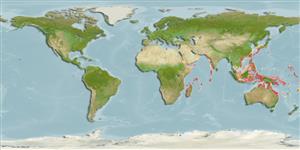Common names from other countries
>
Anguilliformes (Eels and morays) >
Muraenidae (Moray eels) > Muraeninae
Etymology: Gymnothorax: Greek, gymnos = naked + Greek, thorax, -akos = breast (Ref. 45335).
More on author: Bleeker.
Environment: milieu / climate zone / depth range / distribution range
Ecología
marino asociado a arrecife; rango de profundidad 0 - 20 m (Ref. 86942). Tropical
Indo-West Pacific: Oman and India east to Philippines; north to Japan, south to Australia.
Tamaño / Peso / Age
Maturity: Lm ? range ? - ? cm
Max length : 80.0 cm TL macho / no sexado; (Ref. 2334)
Espinas dorsales (total): 0; Radios blandos dorsales (total): 0; Espinas anales 0; Radios blandos anales: 0; Vértebra: 127 - 135. Color pale yellowish; dark brown spots clustering to form larger ones in about 4 irregular rows along the body. Margin of fins white in juveniles; reduced to tip of tail in adults. Vertebrae 127-135.
Found in shallow reefs, including tidepools (Ref 90102); in turbid waters with muddy substrates (B. Haze, pers.comm., 11/2023).
Life cycle and mating behavior
Madurez | Reproducción | Puesta | Huevos | Fecundidad | Larva
Chen, H.-M., K.-T. Shao and C.T. Chen, 1994. A review of the muraenid eels (Family Muraenidae) from Taiwan with descriptions of twelve new records. Zool. Stud. 33(1):44-64. (Ref. 6934)
IUCN Red List Status (Ref. 130435)
CITES (Ref. 128078)
Not Evaluated
Threat to humans
Harmless
Human uses
Pesquerías: sin interés
Más información
ReferenciasAcuiculturaPerfil de acuiculturaRazasGenéticaElectrophoresesheritabilidadEnfermedadesProcesamientoMass conversion
ColaboradoresImágenesStamps, Coins Misc.SonidosCiguateraVelocidadTipo de nataciónSuperficie branquialOtolitosCerebrosVisión
Herramientas
Special reports
Download XML
Fuentes de Internet
Estimates based on models
Preferred temperature (Ref.
115969): 24.7 - 29.3, mean 28.1 (based on 2036 cells).
Phylogenetic diversity index (Ref.
82804): PD
50 = 0.5000 [Uniqueness, from 0.5 = low to 2.0 = high].
Bayesian length-weight: a=0.00032 (0.00021 - 0.00048), b=3.38 (3.26 - 3.50), in cm Total Length, based on LWR estimates for this species & Genus-body shape (Ref.
93245).
Nivel trófico (Ref.
69278): 3.7 ±0.52 se; based on food items.
Resiliencia (Ref.
120179): Bajo, población duplicada en un tiempo mínimo de 4.5-14 años (Preliminary K or Fecundity.).
Fishing Vulnerability (Ref.
59153): Moderate to high vulnerability (52 of 100).
